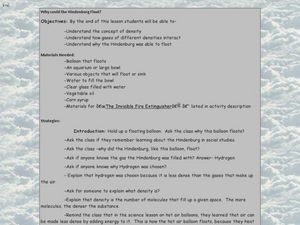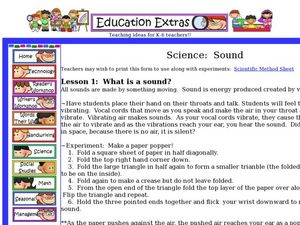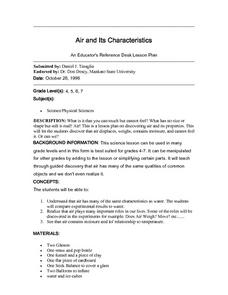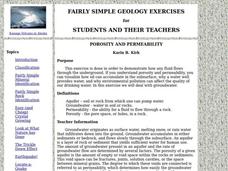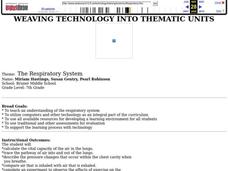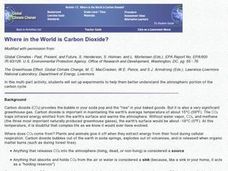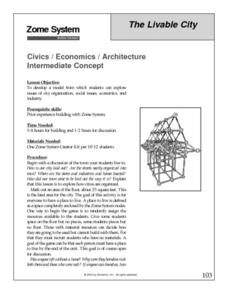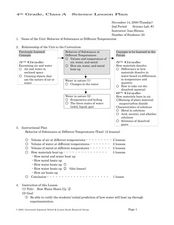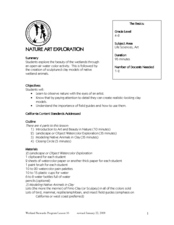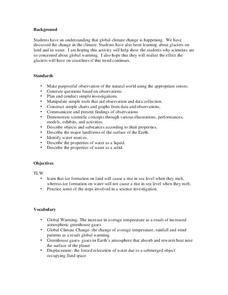Curated OER
Why Could the Hindenburg Float?
Tenth graders experiment with floating and sinking objects and heavy and light liquids, using correct terms, like density, to explain what happens. In this Hindenburg lesson, 10th graders watch a demonstration called the invisible...
Curated OER
What is a Sound?
Second graders explore the concept of sound. In this sound lesson plan, 2nd graders discover what sound, vibrations, and pitch are through several experiments. Students watch a Power Point presentation that allows them to complete a...
Curated OER
Air and Its Characteristics
Students explore air through guided discovery. In this air lesson, students will observe three demonstrations about air. They will answer leading questions as they observe how air displaces and takes up space, how air has weight, and how...
Curated OER
Living Clocks
Students complete experiments to learn about their internal body clocks and physiological activities. In this internal body science lesson, students read "Body Clock Investigations" and complete a body temperature investigation.
Curated OER
Moving Objects
Second graders investigate pushing and pulling. In this lesson plan on how objects move, 2nd graders experiment with marbles to see how one marble can be moved by getting hit by another marble.
Curated OER
Ocean/Beach Center
Students examine different types of ocean life. They classify sea shells and role play in the ocean center. They color and write about their experience in the ocean center and share their experiences with their classmates.
Curated OER
Learning From Leaves: Adaptations To Differing Light Levels
Pupils, in groups, examine plants with different light levels. They are given plants from a tropical and desert region. They write a hypothesis at the beginning of the experiment.
Curated OER
Porosity And Permeability
Learners participate in an exercise/experiment designed to show how environmental pollution can affect the quality of drinking water.
Curated OER
Defining Density as a Relationship
Pupils investigate density and its relationship to air and gas. Students perform experiments to determine if gases have mass. They explore possible ways to figure out the density of gases.
Curated OER
Motion in Fluids
Students explore physical science by participating in a science activity. In this liquids lesson, students discuss how fluids can be affected by motion unlike solids. Students define other scientific vocabulary terms and conduct a motion...
Curated OER
Global Environmental Change
Middle schoolers examine environmental change of land, water, and air, discuss Clear Skies Legislation, and experiment on solid compaction and
resultant water filtration.
Curated OER
A Matter of Fact
Third graders define matter as anything that takes up space and has mass, recognize, through experimentation and observation, that matter exists in three forms, including solid, liquid, and gas, and discuss characteristics of each form...
Curated OER
Floating Vegetables
Students design a craft that safely floats vegetables across a classroom. The teacher provides some materials, but the child may as well. As the experiment is created, they have to fill out worksheets to keep the actiivity organized....
Curated OER
The Respiratory System
The student will calculate the vital capacity of the air in the lungs and trace the pathway of air into and out of the lungs. They describe the pressure changes that occur within the chest cavity when you breathe. They compare air that...
Curated OER
Where in the World is Carbon Dixoide?
Students conduct experiments designed to detect the presence of CO2 by using a BTB that changes color (blue to yellow) in the presence of CO2. First, students experiment with the CO2 from combining vinegar and baking soda. In part two,...
Curated OER
Photographs of Life Cycle of a Butterfly
In this science worksheet, students look at the large color photographs and read simple captions which show the life cycle of a butterfly.
Curated OER
How Water Heats Up
Fourth graders conduct experiments heating water. In this inquiry-based early chemistry lesson, 4th graders use the materials given to experiment with the process of heating water. Students draw conclusions based upon their findings...
Curated OER
How Does Light Travel
Seventh graders design an experiment to determine how light travels. In this physics lesson, 7th graders collect and analyze data. They formulate a conclusion and share results with the class.
Curated OER
Celebrating 100 Years of Flight
Students practice reading comprehension, note taking and writing skills. In this literacy and writing lesson, students read about the invention of airplanes, women pilots and the space race before writing their own news article on "100...
Curated OER
Nature Art Exploration
Students draw a nature landscape using watercolors. In this life science lesson, students share their personal experience on the beauty of nature. They create clay models of different native animals.
Curated OER
Global Climate Change
Second graders investigate the effect of melting glaciers to sea level. In this earth science lesson, 2nd graders simulate the process in the lab by conducting an experiment using ice cubes and clay. They explain the consequences of...
Curated OER
An Invisible Pull
Fifth graders explain why objects thrown upward falls back to Earth. In this earth science lesson plan, 5th graders identify the forces acting on objects. They discuss why planets do not float in space.
Curated OER
Pumpkins
Third graders create a pumpkin lantern. They work in groups to illustrate the growth of a pumpkin seed. Students are asked what they think of when they see the color orange. They choice one person from the group to get a piece of...
Curated OER
Lesson 3: Life Cycle of Brassica Plants
Students investigate the life cycle of brassica plants. For this science lesson, students observe each stage in the life cycle of their plant. Students record their observations and graph the data. Students
